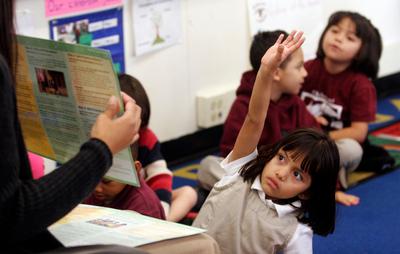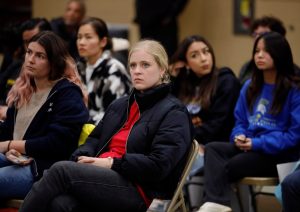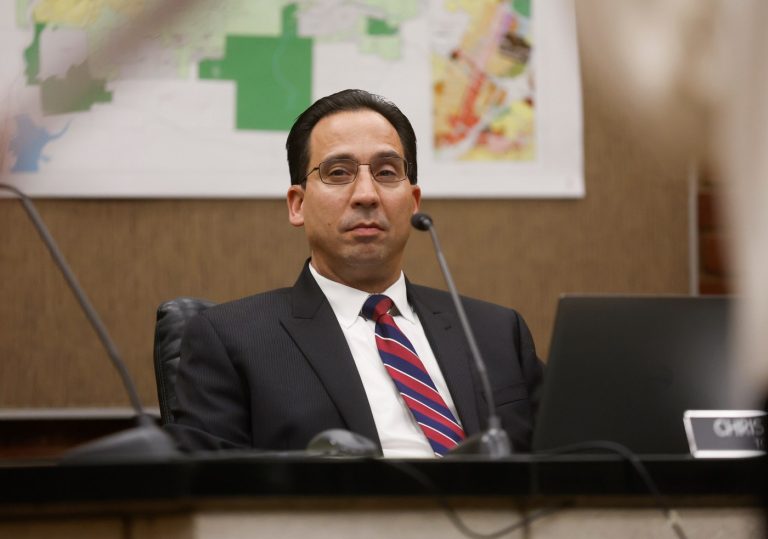The number of students enrolled in California’s ambitious universal preschool program — a new grade for 4-year-olds called transitional kindergarten — has doubled in size over the last two years, the Governor’s Office revealed earlier this month.
Related Articles
Santa Clara County track coach suspected of child sex abuse arrested
What is Project 2025, and how does it target California?
Cupertino students win scholarships for energized videos
Recall vote ousts 2 East Bay school board members who pushed to ban gay Pride flags
Kidnapping attempt at Sequoia High School ends in arrest
But a new study by the University of California at Berkeley finds that growth could come at the cost of existing publicly funded preschool programs and childcare centers, where enrollment has largely leveled-off or declined.
“We don’t quite know where the 3- and 4-year-olds are going,” said Bruce Fuller, co-author of the study and an education professor at UC Berkeley. “Our findings do raise the question of, ‘is the governor overall expanding access to quality pre-kindergarten or is it the same kids moving among different programs?’”
Gov. Gavin Newsom’s $2.7 billion transitional kindergarten program aims to make free, high-quality early education available to every 4-year-old in the state — nearly 400,000 — by the 2025-26 school year, becoming the largest universal preschool program in the country. The program adds a new TK grade to K-12 public schools.
“Parents have more options for their children’s early education today because of the state’s investment in transitional kindergarten,” said a spokesperson for the Governor’s Office.
According to data from the state, TK enrollment increased from around 75,000 in the 2021-22 school year to more than 150,000 in the 2023-24 school year as more 4-year-olds became eligible for the program.
But UC Berkeley’s study, “Tracking Progress, Achieving Fairness,” examined enrollment trends across four preschool programs in the state and found that TK’s enrollment growth could be pulling students from older, community-rooted preschools as childcare centers compete for a shrinking number of early learners.
The study compared transitional kindergarten to three other publicly funded preschool programs in California: California State Preschool Program, a state-funded program for low-income families that serves 3- and 4-year-olds; Head Start, a federally-funded low-income program that serves children from birth to five-years-old; and tuition-charging preschools which accept vouchers for low-income families to obtain care for children ranging from birth to 12-years-old.
The data shows that following the 2020 pandemic, enrollment across publicly funded preschool programs declined, with enrollment in Head Start programs dropping from nearly 95,000 in 2018 to just over 45,000 in 2021 and California State Preschool Program enrollment dropping from more than 187,000 to just over 132,000 in that same period.
The study found that enrollment capacity at tuition charging preschools and family child-care homes — since actual enrollment is unavailable — also took a dive. Tuition charging preschools declined from around 363,000 licensed spots in 2018 to around 343,000 licensed spots in 2021, while capacity at family child-care homes declined from 271,000 in 2019 to 267,000 in 2021.
But two years after the pandemic, publicly funded programs have struggled to bounce back. The data shows that enrollment in Head Start preschool programs has not recovered, remaining at around 46,000 in 2023 while enrollment at California State Preschool Programs has improved slightly at around 141,309 in 2023.
“We don’t know whether those 4-year-olds are going into TK or they entered less formal kinds of care,” Fuller said. “We don’t really know why there’s this migration beyond the fact that public schools are trying to expand TK to get more enrollment and to get stronger state aid.”
Fuller explained that transitional kindergarten’s growth could be driving some private preschools out of business. But other factors — like child-care vouchers — could be working against the state’s goal for universal preschool.
Vouchers allow parents to choose from a variety of available preschool programs, including individual caregivers or family child-care homes. Single or two-person households can earn up to a maximum of nearly $93,000 to be eligible for a voucher, vastly increasing the amount of middle-class families that can participate in the program.
According to UC Berkeley’s study, the number of 3- and 4-year-olds using a portable voucher for early education rose from around 62,800 in 2021 to nearly 75,000 in 2023.
But the increased accessibility to payment vouchers means parents have a bigger choice of programs they can enroll their children in — and they may not choose TK programs at public schools.
Patricia Lozano, executive director of the early-learning advocacy group Early Edge California, explained that location, hours and the type of caretaker all factor into a parent’s decision when choosing a preschool.
“For some parents, they would rather their baby be with a family member or a neighbor, or someone that speaks their language,” she said.
UC Berkeley’s study also looked at the supply of preschool programs by geographic area. In Cupertino, the vast majority of preschool center slots for children were at private, tuition-charging preschools and family child-care homes. Salinas had a larger mix of publicly-funded programs and private preschools, but also a larger number of 3- and 4-year-olds who were not being served by either type of program.
“Part of the problem is that the capacity, the number of classrooms and facilities are expanding but family demand is not necessarily increasing,” Fuller said. “The child population is diminishing, vouchers are growing. So there are these factors that are working against demand for public preschool, even as the governor and the legislature put more money into these programs.”
Looking forward, Fuller said he expects to see TK enrollment continue to grow as enrollment in state preschool declines. And as birth rates continue to drop and families move out of state, Fuller said declining enrollment across all ages will likely continue.
Fuller said the state needs to expand childcare for younger children not served by transitional kindergarten. He said while the state can’t fix birth rates, it can create incentives for preschools to serve infants and toddlers.
Most importantly, the state needs to simplify its preschool programs, he said.
“It’s not clear why we have three different publicly subsidized preschool programs in California,” Fuller said. “And I think the complexity confuses parents and they end up not knowing what options they have. We don’t want three programs competing for the same shrinking count of young children.”












